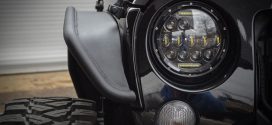|
 Owning an older, more unique vehicle can be one of the most appealing and self-satisfying things in life. Although owning a rarity is exceedingly appealing, it is however, less charming to the pocket book when repairs are needed. In fact, I was so appalled at spending $180 for an alternator and almost $150 for a water pump that I decided that a less expensive alternative was in order. I wedged a Fuel injected Chevy small block under the hood. Fast-forward 3 years or so; I’ve been slowly replacing the worn-out, tired OEM parts for more easily maintainable and less costly parts from Chevrolet. Now, the fanatics can relax, this isn’t another article about swapping your vintage 4-speed Land Cruiser transmission with a Owning an older, more unique vehicle can be one of the most appealing and self-satisfying things in life. Although owning a rarity is exceedingly appealing, it is however, less charming to the pocket book when repairs are needed. In fact, I was so appalled at spending $180 for an alternator and almost $150 for a water pump that I decided that a less expensive alternative was in order. I wedged a Fuel injected Chevy small block under the hood. Fast-forward 3 years or so; I’ve been slowly replacing the worn-out, tired OEM parts for more easily maintainable and less costly parts from Chevrolet. Now, the fanatics can relax, this isn’t another article about swapping your vintage 4-speed Land Cruiser transmission with a  Turbo 350 Chevrolet version (although I’ve done that too). This article is about replacing a stock, worn-out, rusty old junker of a gas tank with a new alternative. Turbo 350 Chevrolet version (although I’ve done that too). This article is about replacing a stock, worn-out, rusty old junker of a gas tank with a new alternative.
After three attempts to fix my leaking, don’t-push-too-hard-your-finger-might-pop-through, gas tank, I was at the end of my rope. (You can see our multiple attempts in this picture at fixing our ailing tank.) Adding salt to the wound, The local Toyota dealer wanted more than 500 clams for a replacement! Where do these people get their prices?!?!
Completely frustrated, I started calling radiator shops to get quotes on fixing my tank. After about 15 phone calls I had two standard answers. 1 – We don’t do that anymore, or 2 – It’ll be a hundred bucks or more and we’ll guarantee it for 30 days. Great, that’s all I need. Throw a $100 or more at a rusted out, filthy, wreck of a gas tank that’s only going to get a 30-day guarantee.
 What to do now? I called a friend of mine for some advice and he recommended giving JT Outfitters in Walnut Cove, N.C. Finally, a break! Their immediate solution? Drop in a 100% polyethylene OEM gas tank replica replacement. This tank is cheap, darn near indestructible and it’ll drop in without hassle. Note our rusted-out, poor excuse of an OEM gas tank on the left, and the shiny-new Poly tank on the right from JT Outfitters. What to do now? I called a friend of mine for some advice and he recommended giving JT Outfitters in Walnut Cove, N.C. Finally, a break! Their immediate solution? Drop in a 100% polyethylene OEM gas tank replica replacement. This tank is cheap, darn near indestructible and it’ll drop in without hassle. Note our rusted-out, poor excuse of an OEM gas tank on the left, and the shiny-new Poly tank on the right from JT Outfitters.
Cut to the chase; JT Outfitters got us exactly what we needed and more. They supplied us with a brand new OEM replica replacement gas tank that would never rust, fit using original hardware, has no welds or seams to fail and wouldn’t crack or become brittle, even at 100 degrees below zero!
Features:
- Nearly 1/4″ thick Polyethylene for incredible strength
- One-piece construction (no welds or seams to fail)
- Never, ever will it rust (thank god!)
- Will always stay pliable, even at 100 degrees below zero
- Installs in a snap
- Uses all OEM equipment (including the sending unit)
- Fuel pickup tube is located on top of the tank
- No more clogged fuel systems from rust or deteriorating sprayed liners
- Affordable!
Installation for this unit was a snap. For the most part, it was a remove and replace installation, except for one small problem that we ran into. The filler neck on this tank was about ¼” smaller than our OEM model, which meant that the filler hose wouldn’t fit securely. We grabbed our OEM filler hose and made a quick trip to the auto-parts store.  Knowing good and well we wouldn’t be able to find a replacement for it, we opted to dig through the catacombs of the radiator hose aisle. After about 20 minutes, we found a radiator hose that had the same bends, curves and most importantly the same inside diameter openings that we needed. Knowing good and well we wouldn’t be able to find a replacement for it, we opted to dig through the catacombs of the radiator hose aisle. After about 20 minutes, we found a radiator hose that had the same bends, curves and most importantly the same inside diameter openings that we needed.
With the new fill hose ready, we set our new tank into the Cruiser. The next step was to install the sending unit. We had to make a few small adjustments to the sending unit as the material this tank is made of is considerably thicker.
 With the sender secured, the next step was to reattach all of the fuel lines and breather hoses. Figuring that now was the best time, we replaced all of the slightly dry rotted fuel lines from the TBI unit all the way to the gas tank. The last thing I want to deal with in the next 2 years is another fuel leak. With the sender secured, the next step was to reattach all of the fuel lines and breather hoses. Figuring that now was the best time, we replaced all of the slightly dry rotted fuel lines from the TBI unit all the way to the gas tank. The last thing I want to deal with in the next 2 years is another fuel leak.
Fuel lines and sending unit all set up, we double-checked the fittings on everything and placed the gas tank cover over the new tank and bolted it down. Before we added any gas, we replaced the fuel filter. With nothing more to do, we added 5 gallons of fresh gas and waited to see if there were any leaks. With no leaks in sight (or smell), we ran the electric fuel  pump a few times to prime the system and then fired the beast up. That’s it, nothing more to it. No leaks, no muss, no fuss. pump a few times to prime the system and then fired the beast up. That’s it, nothing more to it. No leaks, no muss, no fuss.
Four months later, we haven’t had a single problem with our Poly gas tank.
|
 4x4Review Off Road Magazine
4x4Review Off Road Magazine
 Owning an older, more unique vehicle can be one of the most appealing and self-satisfying things in life. Although owning a rarity is exceedingly appealing, it is however, less charming to the pocket book when repairs are needed. In fact, I was so appalled at spending $180 for an alternator and almost $150 for a water pump that I decided that a less expensive alternative was in order. I wedged a Fuel injected Chevy small block under the hood. Fast-forward 3 years or so; I’ve been slowly replacing the worn-out, tired OEM parts for more easily maintainable and less costly parts from Chevrolet. Now, the fanatics can relax, this isn’t another article about swapping your vintage 4-speed Land Cruiser transmission with a
Owning an older, more unique vehicle can be one of the most appealing and self-satisfying things in life. Although owning a rarity is exceedingly appealing, it is however, less charming to the pocket book when repairs are needed. In fact, I was so appalled at spending $180 for an alternator and almost $150 for a water pump that I decided that a less expensive alternative was in order. I wedged a Fuel injected Chevy small block under the hood. Fast-forward 3 years or so; I’ve been slowly replacing the worn-out, tired OEM parts for more easily maintainable and less costly parts from Chevrolet. Now, the fanatics can relax, this isn’t another article about swapping your vintage 4-speed Land Cruiser transmission with a  Turbo 350 Chevrolet version (although I’ve done that too). This article is about replacing a stock, worn-out, rusty old junker of a gas tank with a new alternative.
Turbo 350 Chevrolet version (although I’ve done that too). This article is about replacing a stock, worn-out, rusty old junker of a gas tank with a new alternative. What to do now? I called a friend of mine for some advice and he recommended giving JT Outfitters in Walnut Cove, N.C. Finally, a break! Their immediate solution? Drop in a 100% polyethylene OEM gas tank replica replacement. This tank is cheap, darn near indestructible and it’ll drop in without hassle. Note our rusted-out, poor excuse of an OEM gas tank on the left, and the shiny-new Poly tank on the right from JT Outfitters.
What to do now? I called a friend of mine for some advice and he recommended giving JT Outfitters in Walnut Cove, N.C. Finally, a break! Their immediate solution? Drop in a 100% polyethylene OEM gas tank replica replacement. This tank is cheap, darn near indestructible and it’ll drop in without hassle. Note our rusted-out, poor excuse of an OEM gas tank on the left, and the shiny-new Poly tank on the right from JT Outfitters. Knowing good and well we wouldn’t be able to find a replacement for it, we opted to dig through the catacombs of the radiator hose aisle. After about 20 minutes, we found a radiator hose that had the same bends, curves and most importantly the same inside diameter openings that we needed.
Knowing good and well we wouldn’t be able to find a replacement for it, we opted to dig through the catacombs of the radiator hose aisle. After about 20 minutes, we found a radiator hose that had the same bends, curves and most importantly the same inside diameter openings that we needed. With the sender secured, the next step was to reattach all of the fuel lines and breather hoses. Figuring that now was the best time, we replaced all of the slightly dry rotted fuel lines from the TBI unit all the way to the gas tank. The last thing I want to deal with in the next 2 years is another fuel leak.
With the sender secured, the next step was to reattach all of the fuel lines and breather hoses. Figuring that now was the best time, we replaced all of the slightly dry rotted fuel lines from the TBI unit all the way to the gas tank. The last thing I want to deal with in the next 2 years is another fuel leak. pump a few times to prime the system and then fired the beast up. That’s it, nothing more to it. No leaks, no muss, no fuss.
pump a few times to prime the system and then fired the beast up. That’s it, nothing more to it. No leaks, no muss, no fuss.

